
Kaohsiung is a coastal city in southern Taiwan. It is officially a special municipality with an area of 2,952 km2 (1,140 sq mi) stretching from the coastal urban centre to the rural Yushan Range. As of 2018, the municipality has a population of 2.77 million, making it the third most populous administrative division and second largest metropolis in Taiwan.
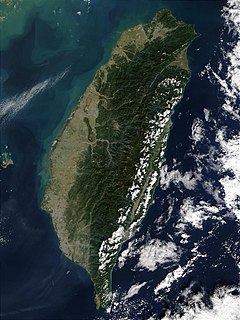
Taiwan, officially the Republic of China (ROC), is an island state in East Asia. The main island of Taiwan, known historically as Formosa, makes up 99% of the area controlled by the ROC, measuring 35,808 square kilometres (13,826 sq mi) and lying some 180 kilometres (112 mi) across the Taiwan Strait from the southeastern coast of mainland China. The East China Sea lies to its north, the Philippine Sea to its east, the Luzon Strait directly to its south and the South China Sea to its southwest. Smaller islands include a number in the Taiwan Strait including the Penghu archipelago, the Kinmen and Matsu Islands near the Chinese coast, and some of the South China Sea Islands.

The national economy of Taiwan, officially known as the Republic of China (ROC), is the 7th largest economy in Asia, and is included in the advanced economies group by the International Monetary Fund and gauged in the high-income economies group by the World Bank, and ranked 15th in the world by the Global Competitiveness Report of World Economic Forum, has a developed capitalist economy that ranks as the 22nd-largest in the world by purchasing power parity (PPP), ranks as 18th in the world by gross domestic product (GDP) at purchasing power parity per capita (person), and 24th in nominal GDP of investment and foreign trade by the Republic of China (Taiwan) government, commonly referred to as Taiwan. As of 2018, telecommunication, financial services and utility services are three highest individuals paid sectors in Taiwan. The economy of Taiwan ranks the highest in Asia for 2015 Global Entrepreneurship Index (GEI) for specific strengths. Most large government-owned banks and industrial firms have been privatized, and now family owned businesses are the streamlined economic factors in Taiwan. With the technocracy-centered economic planning under martial law until 1987, real growth in GDP has averaged about 8% during the past three decades. Exports have grown even faster and since World War II, have provided the primary impetus for industrialization. Inflation and unemployment are low; the trade surplus is substantial; and foreign reserves are the world's fourth largest. Agriculture contributes 3% to GDP, down from 35% in 1952, and the service sector makes up 73% of the economy. Traditional labor-intensive industries are steadily being moved off-shore and replaced with more capital- and technology-intensive industries in the pre-mature stage of the manufacturing industry in the global economic competitions on labor cost, automation, product design realization (prototype), technology commercialization, scientific materialization (patent), scientific discovery, and growing from the over-reliance from the original equipment manufacturer and original design manufacturer models, in which there is no single University from Taiwan entering Reuter's Global Top Innovative 100 University ranking, and the economy of Taiwan may need international collaboration on University, Research and Industrial cooperation on spin-off opportunities. Economy of Taiwan is an indispensable partner in the Global Value Chains of Electronics Industry. Electronic components and personal computer are two areas of international strength of Taiwan's Information Technology industry, which means the economy of Taiwan has the competitive edge on having the learning curve from advanced foreign technologies with lower cost to be produced and sold abroad. Institute for Information Industry with its international recognitions is responsible for the development of IT industry and ICT industry in Taiwan. Industrial Technology Research Institute with its global partners is the advanced research center for applied technology for the economy of Taiwan. Directorate-General of Budget, Accounting and Statistics and Ministry of Economic Affairs release major economic indicators of the economy of Taiwan. Chung-Hua Institution for Economic Research provides economic forecast at the forefront for the economy of Taiwan and authoritatively researches on the bilateral economic relations with ASEAN by The Taiwan ASEAN Studies Center (TASC). Taiwan Stock Exchange is the host to the listed companies of local industries in Taiwan with weighted financial exposures to the FTSE Taiwan Index and MSCI Taiwan Index.
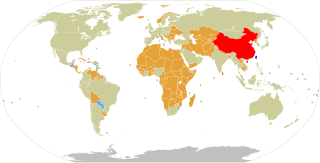
The Republic of China (ROC), referred to by many states as "Taiwan", is recognised by 16 out of 193 United Nations member states, as well as the Holy See. These diplomatic relations do not constitute an international acceptance of Taiwan as a state, but rather represent a recognition of the ROC government as the representative of "China", which means that in the perspective of these countries, the Republic of China is "China", rather than the People's Republic of China, despite the fact that the ROC's controlled area is only less than 1% of "China". In addition to these relations, the ROC maintains unofficial relations with 57 UN member states via its representative offices and consulates. The ROC passport has 124 countries and Hong Kong reciprocally exchange visa exemption agreements as of 2018.
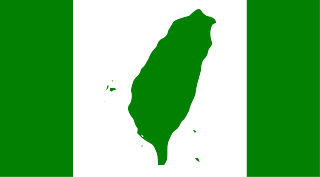
The Taiwan independence movement is a political and social movement which aims to establish an independent sovereign state on the archipelagic territory of "Taiwan", preferably being officially known as the "Republic of Taiwan", with a unique "Taiwanese national identity".
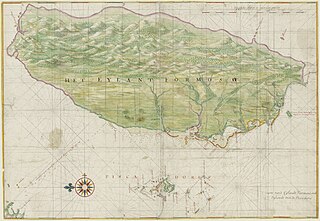
The history of the island of Taiwan dates back tens of thousands of years to the earliest known evidence of human habitation. The sudden appearance of a culture based on agriculture around 3000 BC is believed to reflect the arrival of the ancestors of today's Taiwanese indigenous peoples. The island was colonized by the Dutch in the 17th century, followed by an influx of Han Chinese including Hakka immigrants from the Fujian and Guangdong areas of mainland China, across the Taiwan Strait. The Spanish built a settlement in the north for a brief period but were driven out by the Dutch in 1642.

Taiwanese indigenous peoples or formerly Taiwanese aborigines, Formosan people, Austronesian Taiwanese or Gāoshān people, are the indigenous peoples of Taiwan, who number almost 569,008 or 2.38% of the island's population—or more than 800,000 people, considering the potential recognition of Taiwanese plain indigenous peoples officially in the future. Recent research suggests their ancestors may have been living on Taiwan for approximately 5,500 years in relative isolation before a major Han immigration from mainland China began in the 17th century. Taiwanese aborigines are Austronesian peoples, with linguistic and genetic ties to other Austronesian people. Related ethnic groups include Polynesians, most people of the Philippines, Indonesia, Malaysia and Brunei, among others.

Mainland China, also known as the Chinese mainland, is the geopolitical as well as geographical area under the direct jurisdiction of the People's Republic of China (PRC). It includes Hainan island and strictly speaking, politically, does not include the special administrative regions of Hong Kong and Macau, even though both are partially on the geographic mainland.

Taipei, officially known as Taipei City, is the capital and a special municipality of Taiwan. Located in the northern part of the Island of Taiwan, Taipei City is an enclave of the municipality of New Taipei City that sits about 25 km (16 mi) southwest of the northern port city Keelung. Most of the city is located in the Taipei Basin, an ancient lakebed. The basin is bounded by the relatively narrow valleys of the Keelung and Xindian rivers, which join to form the Tamsui River along the city's western border.
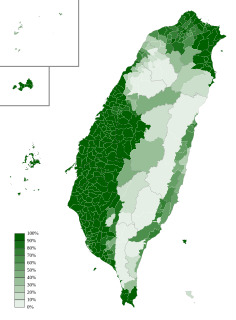
Taiwanese Hokkien, also known as Taiwanese Min-nan or simply Taiwanese, is a variety of Hokkien Chinese spoken natively by about 70% of the population of Taiwan. It is spoken by the Taiwanese Hoklo people, who descended from immigrants from southern Fujian during the Qing dynasty. The Pe̍h-ōe-jī (POJ) romanization is a popular orthography for this variant of Hokkien.
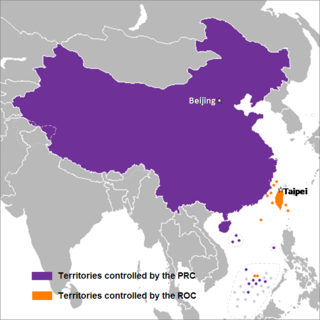
Chinese (re)unification, more specifically Cross-Strait (re)unification, is the irredentist concept of Greater China that expresses the goal of (re)unifying the alleged mainland region of China and Taiwan region under the same real administration.

The controversy regarding the political status of Taiwan, sometimes referred to as the Taiwan Issue or Taiwan Strait Issue, or from a Taiwanese perspective as the Mainland Issue, is a result of the Chinese Civil War and the subsequent split of China into the two present-day self-governing entities of the People's Republic of China and the Republic of China.

"One-China policy" is a policy saying that there is only one sovereign state under the name China, despite the fact that there are two states, the People's Republic of China (PRC) and the Republic of China (ROC), whose official names incorporate "China". Many states follow a one China policy, but the meanings are not the same. The PRC exclusively uses the term "One China Principle" in its official communications.
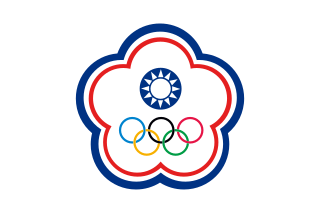
"Chinese Taipei" is the name for Taiwan designated in the Nagoya Resolution whereby the Republic of China (ROC) and the People's Republic of China (PRC) recognize each other when it comes to the activities of the International Olympic Committee. The ROC participates under this name in various international organizations and events, including the Olympic Games, the Little League World Series, International Tennis Federation sanctioned tournaments, the Australian Open, the French Open, Wimbledon, the US Open, Paralympic Games, Asian Games, Asian Para Games, Universiade, International Powerlifting Federation, FIFA, the World Kendo Championship, the Overwatch world cup and other esports tournaments, Miss Universe, Miss Chinese International Pageant, FIRST Global, the Metre Convention, and the World Health Organization.

The New Taiwan dollar is the official currency of the Republic of China (ROC) used in the Taiwan Area. Formally, one dollar (圓) is divided into ten dimes (角), and to 100 cents (分), although cents are never used in practice. The New Taiwan dollars has been the currency of Taiwan since 1949, when it replaced the Old Taiwan dollar, at a rate of 40,000 old dollars per one new dollar. There are a variety of alternative names to the units in Taiwan. The unit of dollar is usually written in simpler form as 元. Colloquially, the currency unit is called 塊 in Mandarin, 箍 in Taiwanese Hokkien, and 銀 in Hakka.

Tsai Ing-wen is a Taiwanese politician and professor who is currently serving as the President of the Republic of China, commonly known as Taiwan, since May 20, 2016. The first woman to be elected to the office, Tsai is the seventh president of the Republic of China under the 1947 Constitution and the second president from the Democratic Progressive Party (DPP); part of Taiwan's Pan-Green Coalition. She is also the first president to be of both Hakka and aboriginal descent, the first unmarried president, the first to have never held an elected executive post before presidency and the first to be popularly elected without having previously served as the Mayor of Taipei. She was the Democratic Progressive Party candidate in the 2012 and 2016 presidential elections. Tsai previously served as party chair from 2008 to 2012, and from 2014 to 2018.
Taiwanese people are people from Taiwan who share a common Taiwanese culture and speak Mandarin Chinese, Hokkien, Hakka, or Aboriginal languages as a mother tongue. Taiwanese people may also refer to individuals who either claim or are imputed cultural identity focused on Taiwan or areas under the control of the Government of the Republic of China since 1945, including Penghu, Kinmen, and Matsu islands. At least three competing paradigms are used to identify someone as a Taiwanese person: nationalist criteria, self-identification criteria, and socio-cultural criteria. These standards are fluid, and result from evolving social and political issues. The complexity resulting from competing and evolving standards is compounded by a larger dispute regarding Taiwan's identity, the political status of Taiwan, and its potential de jure Taiwan independence or Cross-Strait Unification.

Japanese Taiwan was the period of Taiwan and the Penghu Islands under Japanese rule between 1895 and 1945.



















